
The Bottom Line
Introduction and Availability & Price
GIGABYTE is a veteran of the laptop industry, having quite a bit of experience in making some very fine examples of laptops in all price ranges and segments. They also have the ability to control the majority of the manufacturing process with their exceptional OEM and ODM reach. That's a win for the consumer in more ways than one.
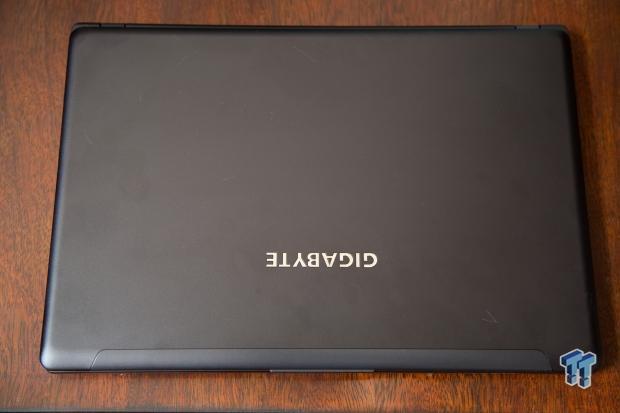
The P34 line of laptops has been updated to the fifth version, updating everything inside to include the latest in technologies available. That means they've packed an Intel Skylake mobile CPU, NVIDIA Maxwell dGPU, and NVMe storage, plus a higher-resolution screen to make for a budget-friendly, but not "budget" per-se, machine for the gamer that doesn't need the flair of some gaming-focused machines.
And really it's a smart move. Offer a powerful machine that has everything the mobile gamer wants, but just keep the chassis a bit more generic-looking to keep costs down. The bezels aren't razor thin, and it's not a complete slab of machined aluminum, but it has everything else some of those more expensive machines don't have, and for a price that's lower. It almost represents the perfect machine, too, considering the boxes it checks.
GIGABYTE wants to woo everyone with this, as it has for four previous generations. How does it stack up to the competition?
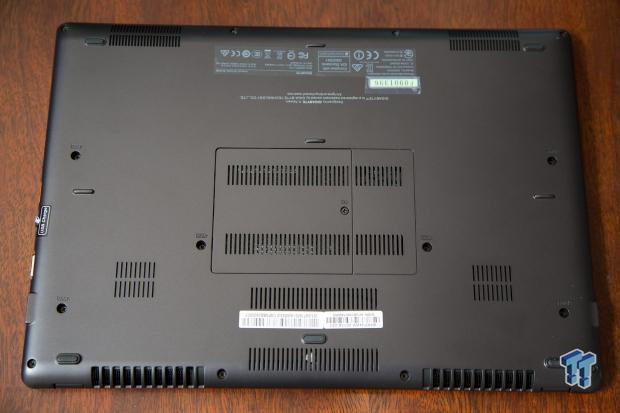
Availability & Price
The GIGABYTE P34W v5 is now widely available from your favorite retailer. There are two variations that you'll find out in the wild. The first is denoted by an SL designation after the model number and has a full HD screen combined with 8GB of RAM, which retails for $1599. The second is the one tested here, designated by SL3K2, which comes with 16GB of RAM and a 1440p screen and retails for $1799.
Specs, Configurations Available, Warranty & Support
Specifications
The GIGABYTE P34 series comes in a number of different configurations to accommodate a lot of different price point. They all have a 6th generation Intel Skylake i7-6700HQ CPU under the good, but with varying degrees of storage, RAM, and dedicated GPU on board. This particular model is the W variant that comes with a 970M and the optional 2560x1440 resolution IPS screen. In addition to that, 16GB of DDR4-2133MHz memory is installed, and upgradable as well. There's a 128GB Samsung NVMe compliant PCIe M.2 SSD and an additional 1TB of storage via a Hitachi-sourced HDD.
Though the 14" laptop is packed with power, they've also managed to put a massive battery into the chassis. It's fairly small at 20.8mm thick and only weighs a scant 3 pounds. Taking up the majority of that weight is the battery, which is a massive 61.25Wh in total capacity. That's one of the largest batteries offered in a laptop of this size, bar Apple's offerings, and without an external battery solution.
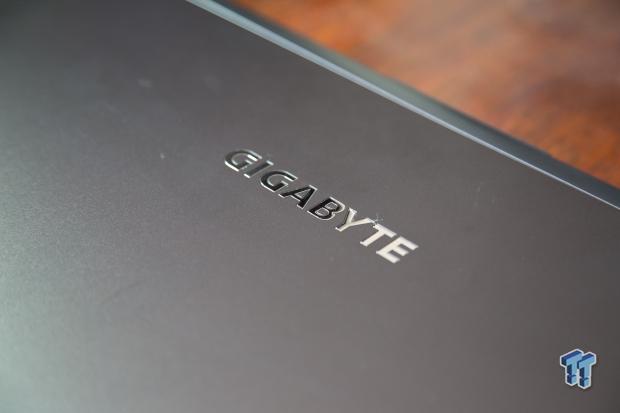
Configurations Available
There are two primary configurations available to the consumer, the SL2, and SL3K2, which denote different resolutions; 1080p and 1440p, respectively. The SL2 version also has only 8GB of RAM. The rest of the specs are similar.
Warranty & Support
GIGABYTE has a 24-month worldwide warranty that applies to the P34W v5, which just happens to be a year longer than quite a few different manufacturers. The only limitation is that the batteries and AC adapter are only covered for the first year, and any other bundled accessories are excluded from the warranty.
Detailed Look, Outputs & Connectivity
Detailed Look - The Monolithic Brick of Magic
The GIGABYTE P34 v5 isn't going to win any design awards, but then it wasn't created quite for that purpose. It is attractive, but in that strangely industrial kind of way. It sits there like a brick, though not an ugly brick, that has a distinct purpose, and its outward appearance wasn't the focus. The good thing is that it fits well within nearly any decor, and won't draw too much attention if you whip it out in public. It doesn't look like the beast that's contained within, which is okay considering what hardware it's running. Not everyone needs a gaudy looking laptop to draw attention to their gaming habits.
The chassis is primarily made primarily of aluminum, with the bezels and bottom consisting of the only plastic on the machine. The aluminum parts are designed to resist fingerprints, but I found that natural oils were still picked up and shown, but were easily wiped clean. The bottom is well ventilated with the intake on the bottom, with raised feet to allow for a fairly uninterrupted flow of more cool air into the chassis, and out the back. There's a bit of flex in the chassis if you press on the bottom near the grates, but it isn't terribly worrisome. Unless you're some kind of savage that uses your laptop as a bludgeon, then it should be more than fine.
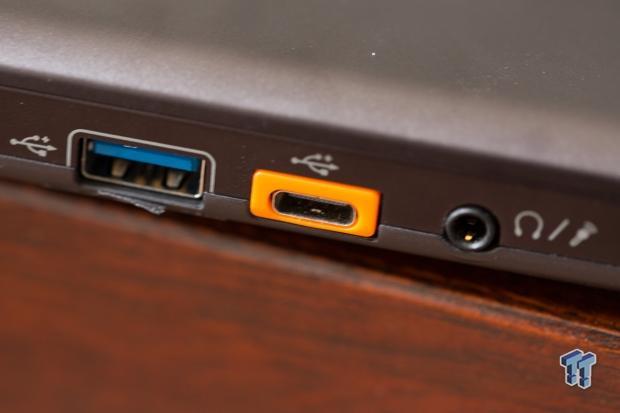
Outputs & Connectivity
Connectivity is abundant on this laptop. There's more here to connect that one could need, and even an older VGA output for the budding business-being that still has an old projector (a surprisingly useful port, by the way). Along the sides, we have three traditional USB 3.0 ports, a USB 3.1 Type-C port, HDMI 2.0 out, an RJ45 LAN port, SD card reader, and that lovely D-sub out that, while legacy, is appreciated in some circles. Not everything is beamed wirelessly quite yet.
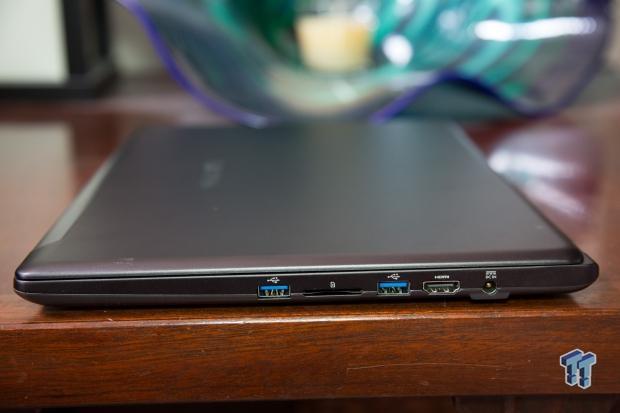
Wireless connectivity is handled by an Intel Centrino (remember when those were processors?) Wireless-AC8260 that's dual band with a 2x2 configuration that's capable of up 802.11ac up to 867Mbps. It also provides Bluetooth 4.2 wireless connectivity as well, which includes all the great things such as EDR, low energy, etc. Everything one needs, the specs are definitely not lacking in any area, at least internally.
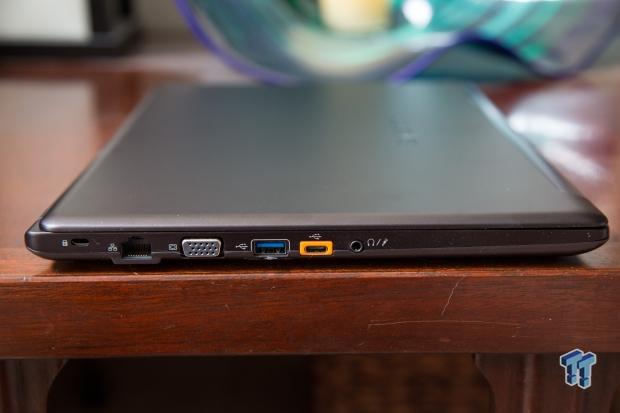
Display, Keyboard, & Trackpad
Display
The 14-inch display itself is an IPS model made by LG and is capable of producing some very nice, rich colors. The 2560x1440-pixel resolution is sufficient at this size, and you'll be hard pressed to pick out individual pixels at all. Details were crisp, and Windows seemed to scale well at this pixel density of 210 PPI. It's a little dim compared to what some might be used when the brightness is turned all the way up, capable of only 288 cd/m^2 of brightness. That's not terrible, but it also means it's not readable in direct sunlight. Though I'm not sure why you'd want to take this, or any laptop, out and orient the screen towards the sun anyway.
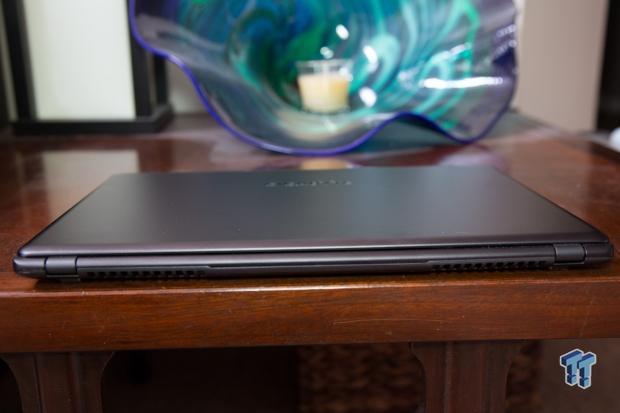
Testing it with an X-Rite i1Pro Basic 2 showed that the screen is capable of nearly 77% of the sRGB color spectrum, which translates to around 49% of the AdobeRGB 1998 spectrum. When calibrated, we noted a contrast ratio of 731:1 with a black level of 0.36. It's not the best screen on the market, but not terrible either. What might be off-putting are the bezels, which are fairly thick, though the color of them does help to minimize their appearance when you're actively concentrating on what you're doing on screen.
The resolution itself is fantastic for desktop work, and can even do well for games, but let's be honest and practical. It's not going to always be capable of playing all your favorite games at that resolution, and thankfully it scales well to 1920x1080 with minimal problems. There's a slight bump in brightness, but text is more than legible, and the screen still looks great despite it not being the native resolution.
Keyboard & Trackpad
A good trackpad can make or break a laptop. Maybe I've been spoiled by the smooth and well-designed trackpads on Macs for the past few years, or maybe I'm just a trackpad enthusiast. Either way, if the default method of interacting with your shiny new device doesn't quite work so well, then it can become frustrating very off putting. The Elan-sourced touchpad is a bit strange to use compared to the Synaptics or even those made by Apple. The surface itself is smooth, but even with sensitivity turned up, it's difficult to move around as much as I'd like. The software is also a bit less intuitive, and there are issues with the pointer jumping at times when you're trying to perform any of the Windows multi-touch gestures. You'll likely appreciate plugging in a mouse here.

Speakers & Sound
Speakers
The sound is handled by two 1.5W speakers that are located underneath the chassis. Laptop audio has come a long way regarding quality compared to the small area that they're stuffed into. Physics somewhat limit how loud and full these speakers can get due to the lack of volume to move massive amounts of air. But here, they're adequately placed and large enough to make an impact around you.
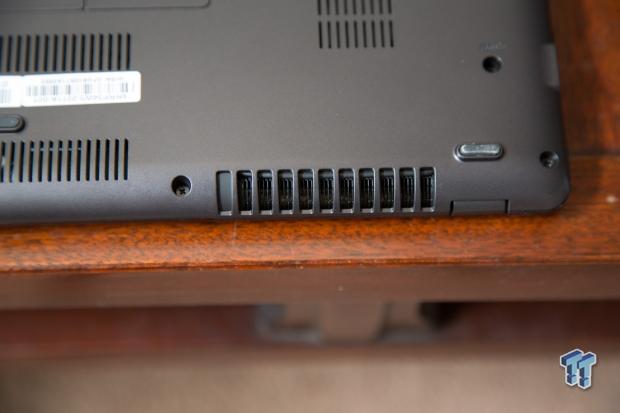
Accompanying the speakers is a combo audio jack that doubles as both microphone and headphone jack. It's powered but isn't potent enough for higher-end audiophile headphones. Included is Dolby's Digital Plus Home Theater software to add a virtual surround effect to any set of 3.5mm headphones you connect. Through the interface, you can use custom profiles based on what you're listening to, whether that be music, movies or games. It doesn't sound too bad, and there's no audible feedback when using even very sensitive IEM's, like the Shure SE846's.
Sound Output
But how does it actually sound? Those tiny speakers in the front are a surprising source of sonic sorcery. They won't wow you with their ability to rock your socks, but they will get loud enough, without distortion, to be a good way to listen to whatever YouTube, Netflix of Hulu content you put on screen. It isn't tinny by any means, but it isn't precisely "full" sounding either. There's a distinct lack of bass due to the laws of physics, but voices especially sound quite good all things considered.
When chatting, you can use the virtual surround feature to increase the dialogue clarity, making it very easy to hear anyone through Skype or whatever your favorite chat app is. It's sound from a laptop, but it's decent sound from a laptop. I'm not certain who would use laptop speakers as their primary source of sound when they have a good pair of headphones lying around anyway. We measured distortion free audio up to 87 dBa. Again, it lacked a bit of bass but was otherwise acceptable.
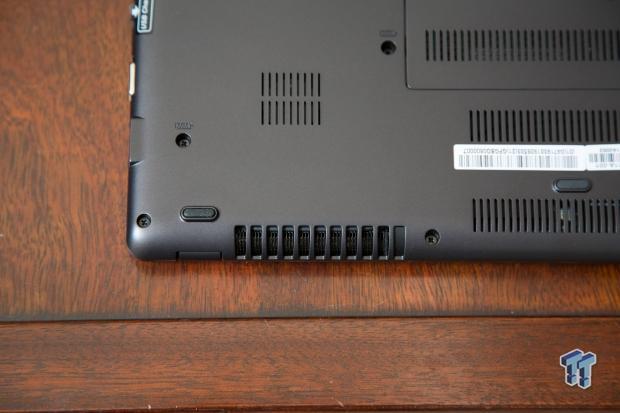
And while it doesn't exactly have a built-in amplifier, it's capable of clear sound without much effort. The bass, due to the lack of proper amplification, is a bit light and what's there seems to be slightly muddy in comparison to using a dedicated external amplifier, but it's sufficient. The virtual surround effect is what you'd expect it to be, good but not exactly the most convincing using a binaural audio solution. It's calculated with spare CPU cycles and sounds pretty good, though not necessarily with the most convincing of 3D sound.
Everyday Use
Using the P34W v5 – Everyday Musings
The size is a real positive here with the P34W v5. It's slim and comfortable to use on your lap when you need to get work done. The keyboard is more comfortable to type on than you might think, too. The slightly (only very) mushy keys make a good impression of a mechanical keyboard. There's a certain amount of slack and an actuation point that's easy to predict each time. Whether that's by design, or not, I don't know, but the effect is pleasing to type on. Using it every day is a treat. It does what it's supposed to and when you ask it. The battery life isn't exactly mind-blowing, but it's enough endurance to let you get through a normal work day without having to be tethered to the wall.
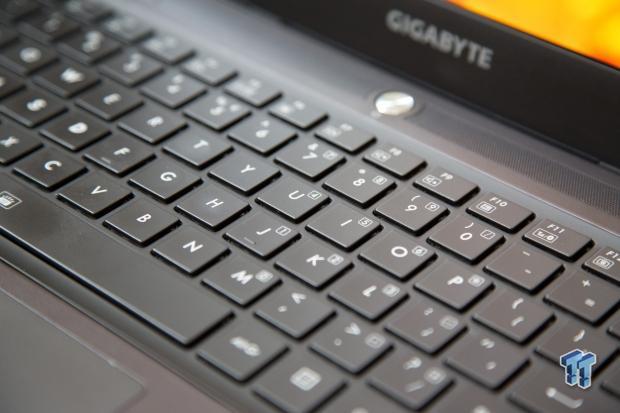
That size again is what makes it a more useful laptop in everyday life. Too thin and it's weird on your lap, too big and it starts getting uncomfortable. Here it's almost a perfect blend though you're greeted with the slightly annoying sounds of tiny fans that are (efficiently, however) moving heat away from those precious parts are onto your lap.
It gets hot when in actual use, but at least that hot air means that the components are being cooled efficiently. The cooling system they've designed here can move a lot of heat very quickly, but it all ends up on you, which is great when it's cold outside but quickly becomes pretty terrible. The exhaust is located on the back, which doesn't pose any problems.
Gaming Use
Gaming on the P34W v5 – a surprisingly superb experience
Gaming is precisely the market that this laptop is being targeted towards. The specs look absolutely perfect for a small round of gaming while on the go. The NVIDIA GeForce GTX 970M is theoretically a decent performer for a variety of games, as you'll see in a little bit. You shouldn't be under any illusions that newer games with sophisticated graphics can be played at the native resolution with everything turned on, but that's to be expected. You have to make trade-offs when you look at mobile gaming. There's only so much that any laptop can actually do. There are always limitations, but here those limitations can be traded for either maximum fidelity at 1080p or less visually pleasing, yet at 1440p, not a bad predicament to be in with a slimmer chassis.
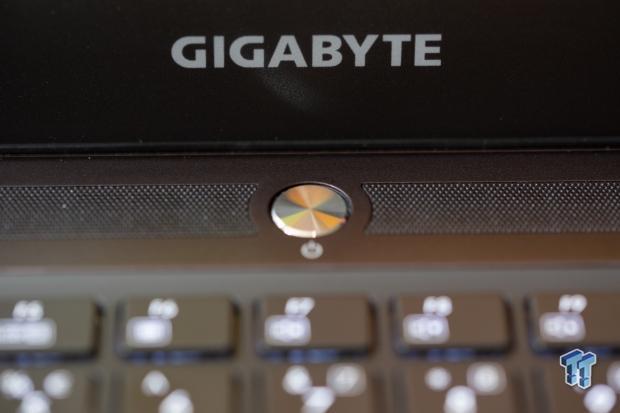
So it isn't the fastest, doesn't have the desktop 980 hidden away inside, but it doesn't need it either. The price says it all, and the 970M is the perfect companion for nearly anything you could ever want to play. It's my experience that when I travel, I largely game very little but instead rely on that hulking GPU to help do some compute work while plugged in. But for those that do enjoy more intense sessions of gaming, then this little laptop can get the job done, though perhaps not as efficiently as others, but it does it at a price that's far more reasonable on the wallet.
Let's take a look at our normal slew of benchmarks to see how it performs. The P34W v5 is capable of gaming on quite a few different titles at 1440p though it isn't exactly going to excel at those resolutions with all the details turned on. For that reason, we've benchmarked this system at 1080p only.
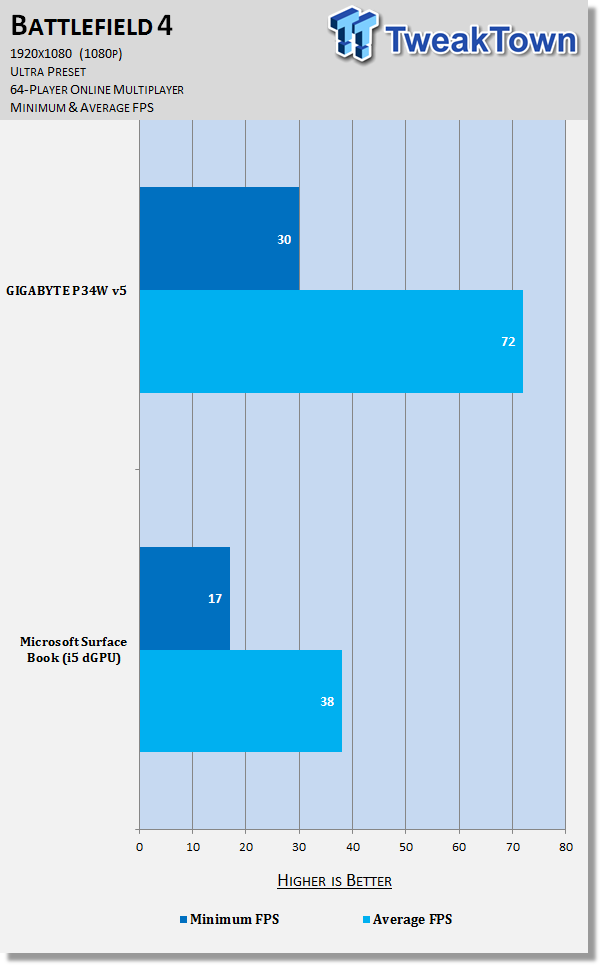
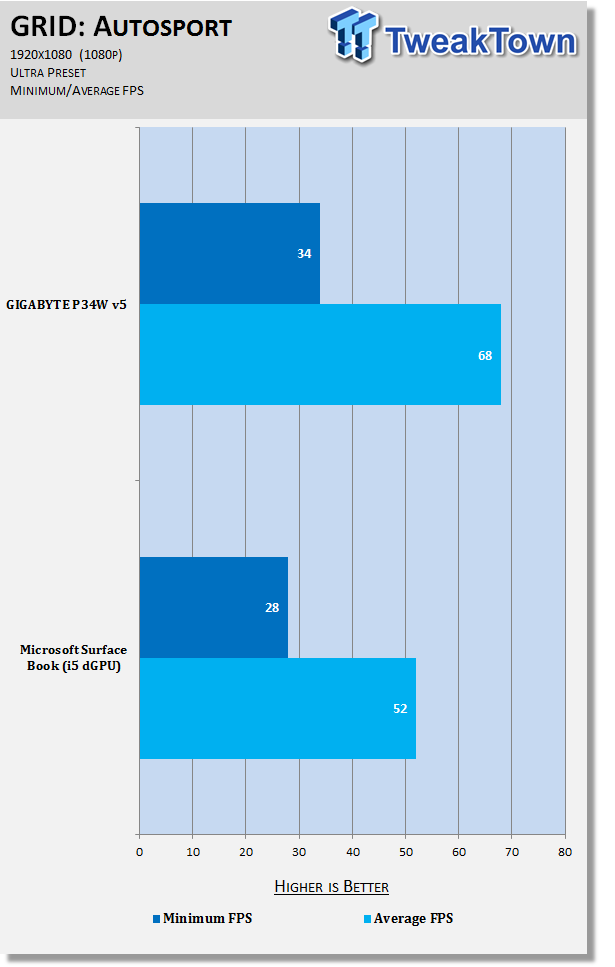
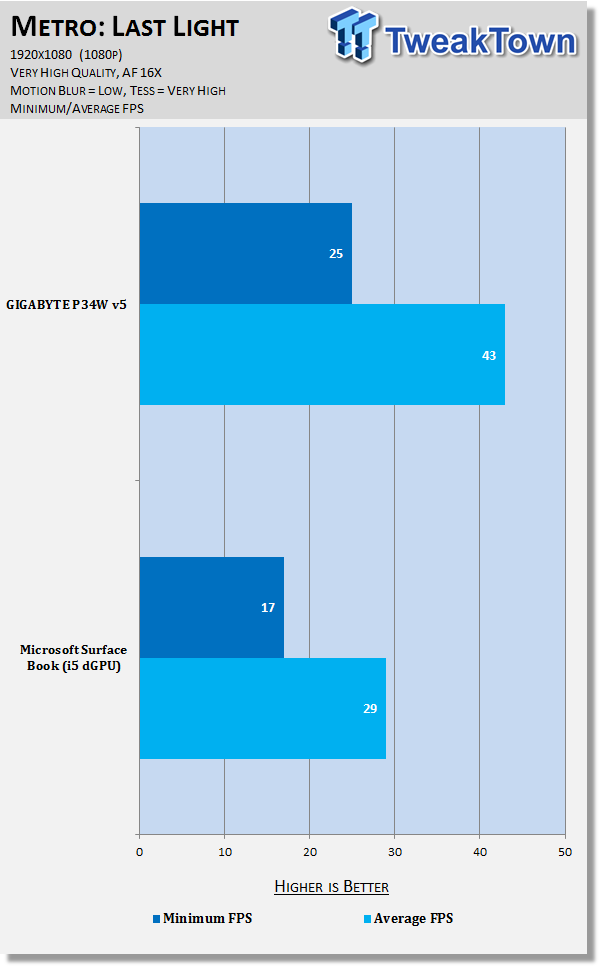
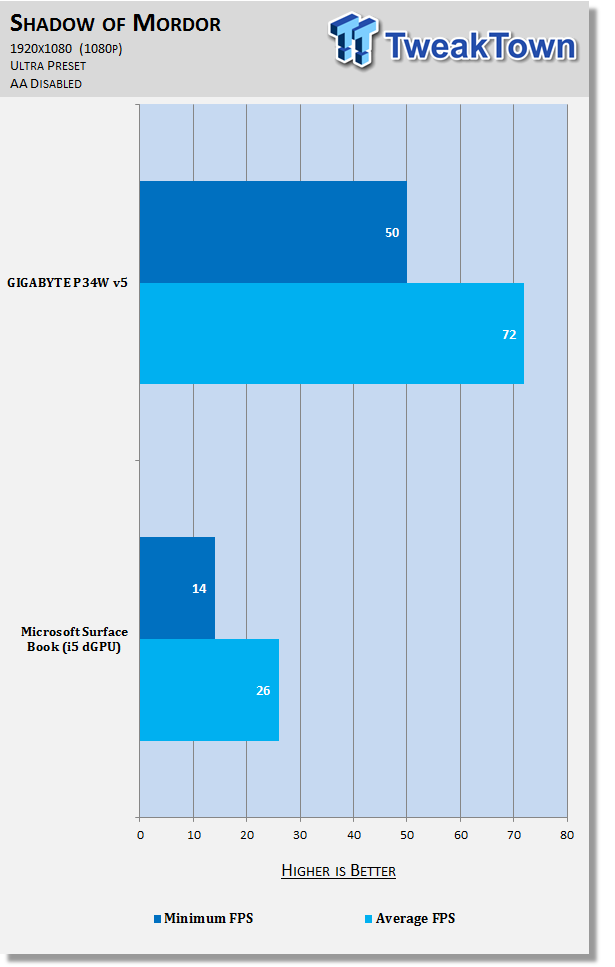
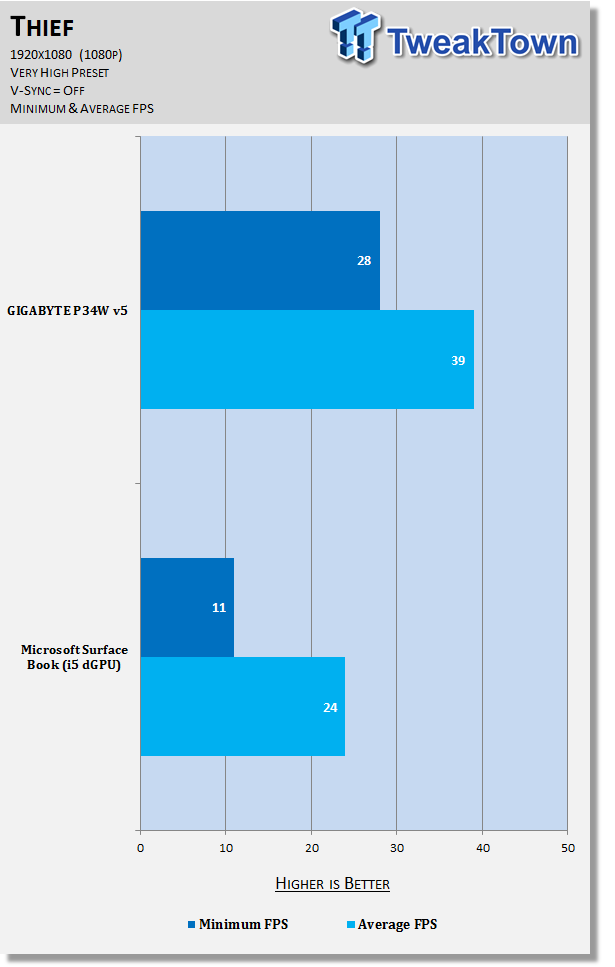
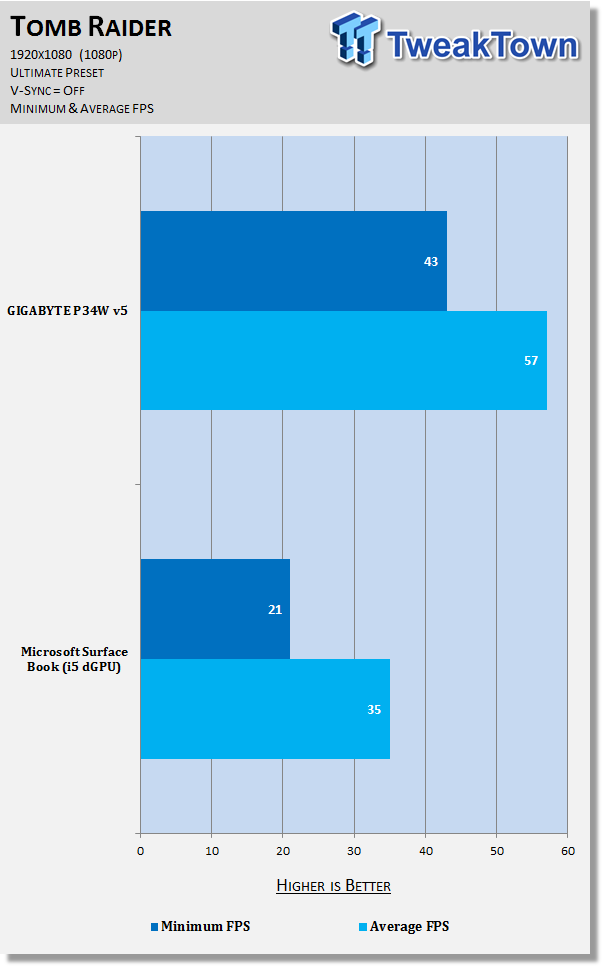
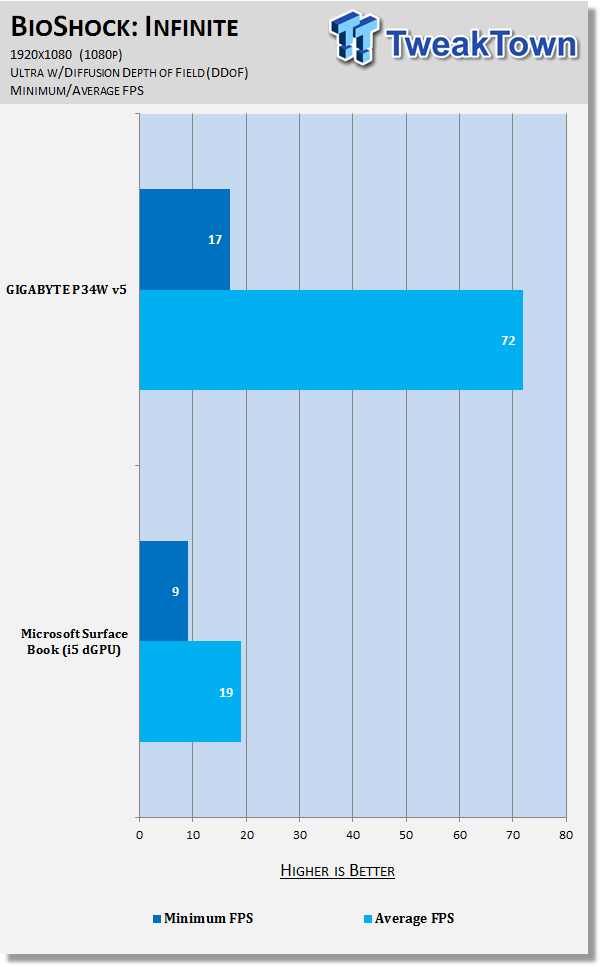
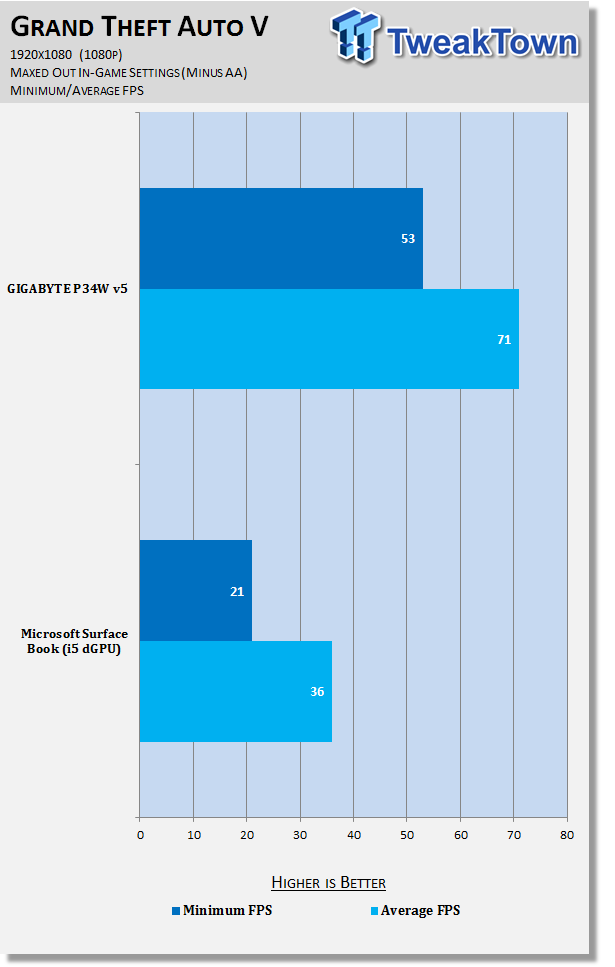

1080p at this screen size actually looks rather good, and there doesn't appear to be any stretching or other artifacts or issues as a result of using a resolution that's less than native. Games run smooth, too smooth. It's a capable machine. In gaming scenarios, it does get hot, around 70-degrees Celsius.
But what of games you may not necessarily see in normal benchmarks? How well does this laptop perform in other games? We have a game compilation that'll continue to become larger as games are released. Listed are the average framerates of games; all played at 1080p and the maximum settings possible, sans AA.
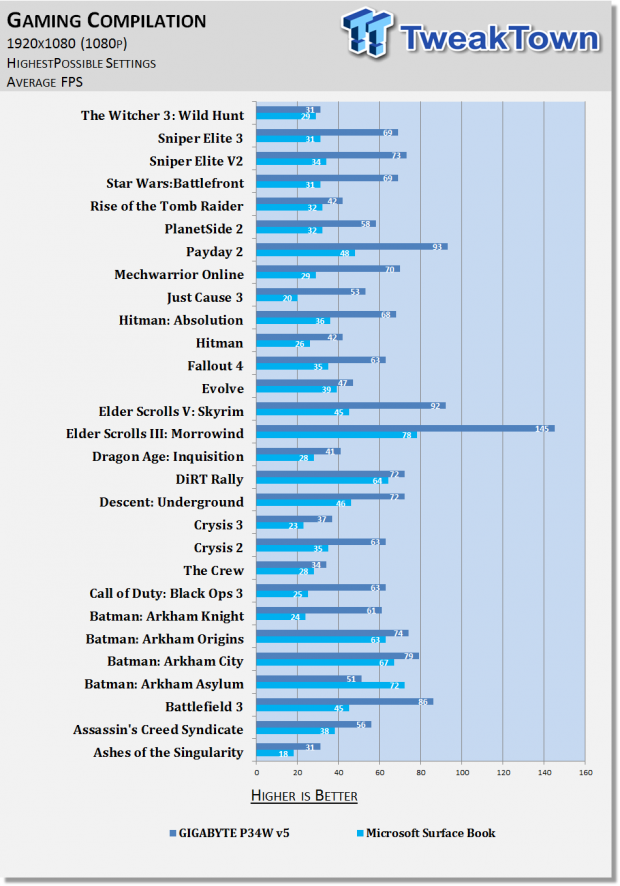
Benchmarks - CPU & RAM
Benchmarks, turning the tide on laptops
The Intel Core i7-6700HQ CPU is nearly the standard you'd expect in a gaming laptop of this size. Its nominal speed of 2.6GHz with a 4-core boost speed of 3.1GHz is generally sufficient for most tasks and is faster than the i7-4702HQ, though not always by much. We test in a multitude of different applications for the CPU performance. We include Cinebench R15, the X264 FHD Benchmark, Google Octane 2.0, Mozilla Kraken, and WinRAR to represent real-world workloads that you might encounter.
First, let's take a look at just how fast the DDR4 RAM actually is, especially when compared to its DDR3L counterpart.
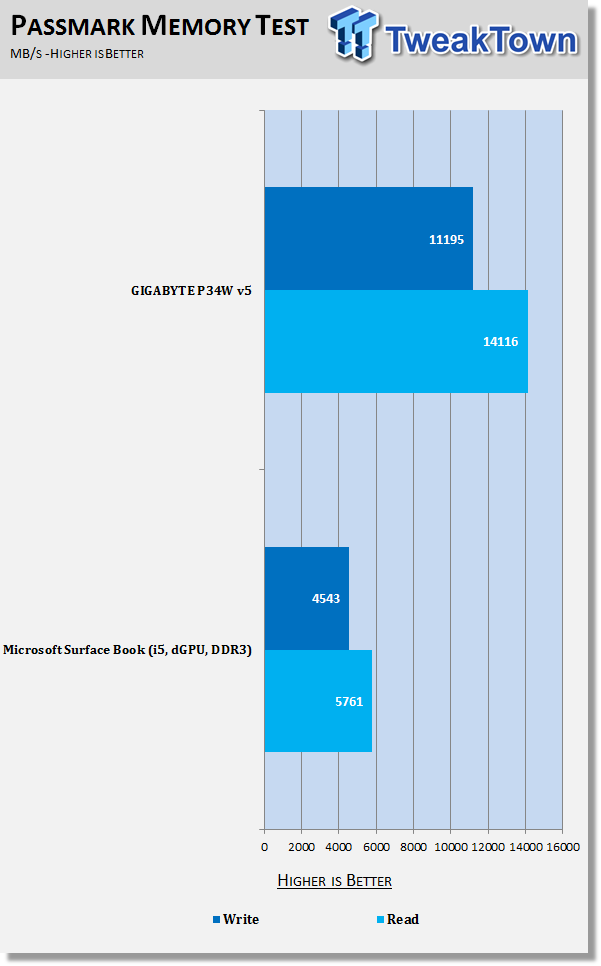
Not a terrible result, and certainly much faster than last generation's DDR3, which can also be found paired with some systems running certain U series Skylake processors. It's fast enough; that's for certain.
Next, we'll take a look at how fast it can render in Cinebench R15, both with a single core and with all cores running. With all cores running, this test should be able to sustain the four-core boost of 3.1GHz, and heat shouldn't be an issue.
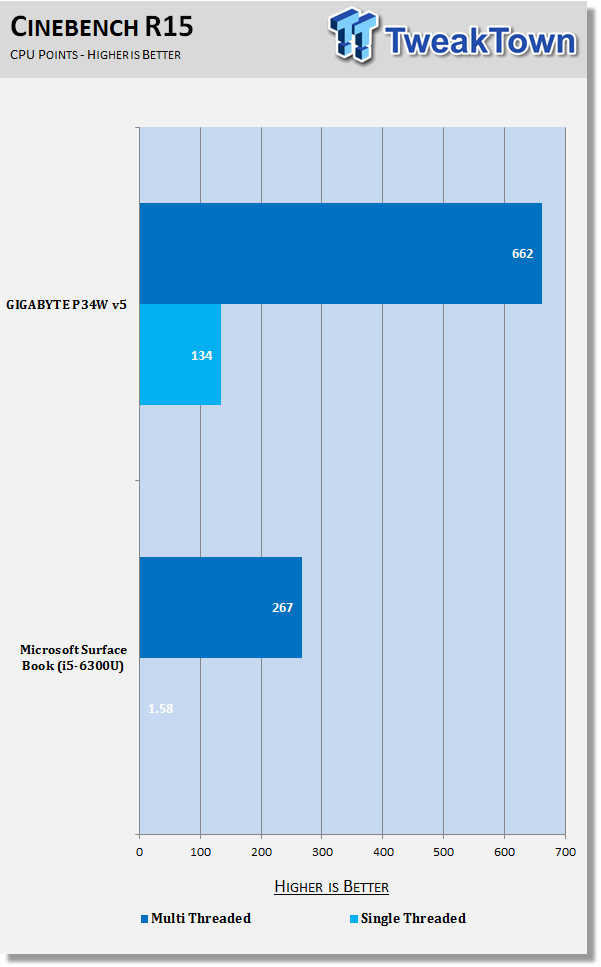
The result is precisely what we expect given the 6700HQ inside. Multi-core performance specifically is more than adequate. The next test will see how fast it can encode a movie file into the X264 format using the standardized X264 FHD Benchmark.
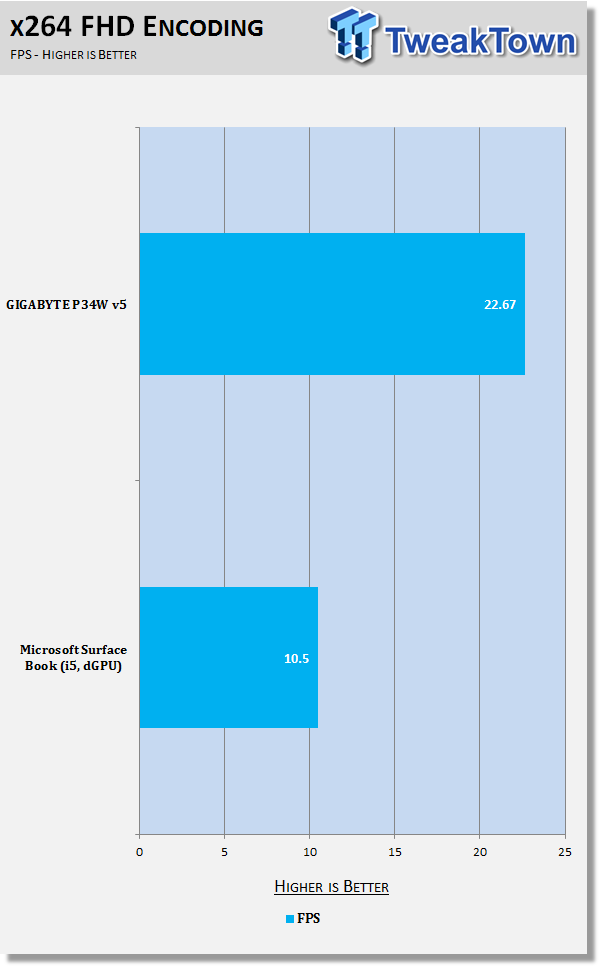
The higher the frames-per-second, the faster it's able to encode the video. 22.67fps is fast given that it's using the CPU only. That's much faster (naturally) than the Surface Book, and is not too shabby. Now on to the browser based benchmarks that stress various operations and workloads you'll encounter throughout your day. Octane 2.0 is first, then we'll unleash the Kraken.
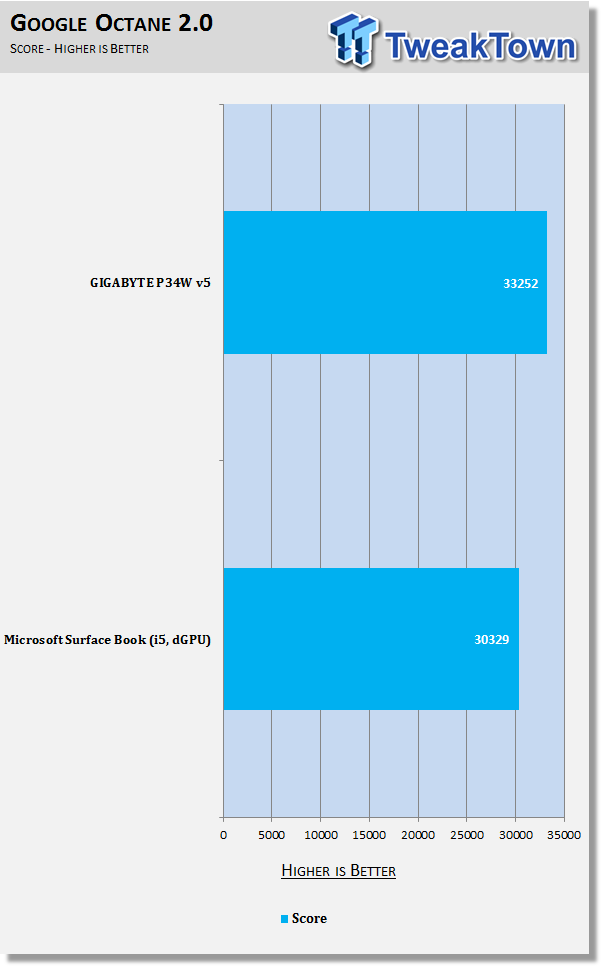
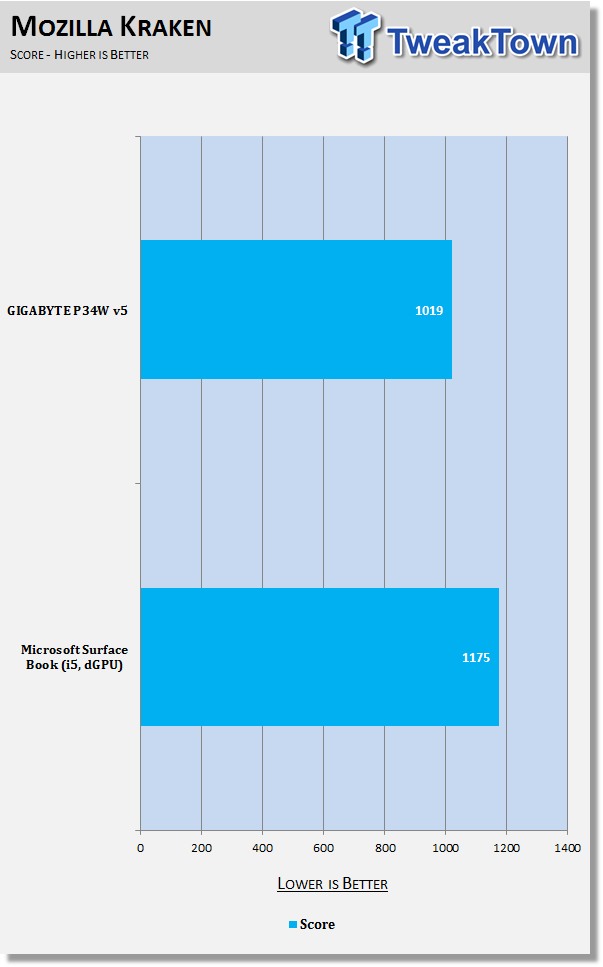
Scores of 33,252 and 1019 respectively are respectful, though perhaps we'd expect a bit more performance out of the Karken as it's not terribly far off from the Surface Book's i5-6300U. Definitely fast enough, more than fast enough. WinRAR is up next. Compression and decompression is mathematically intense and done on a more regular basis than you might realize.
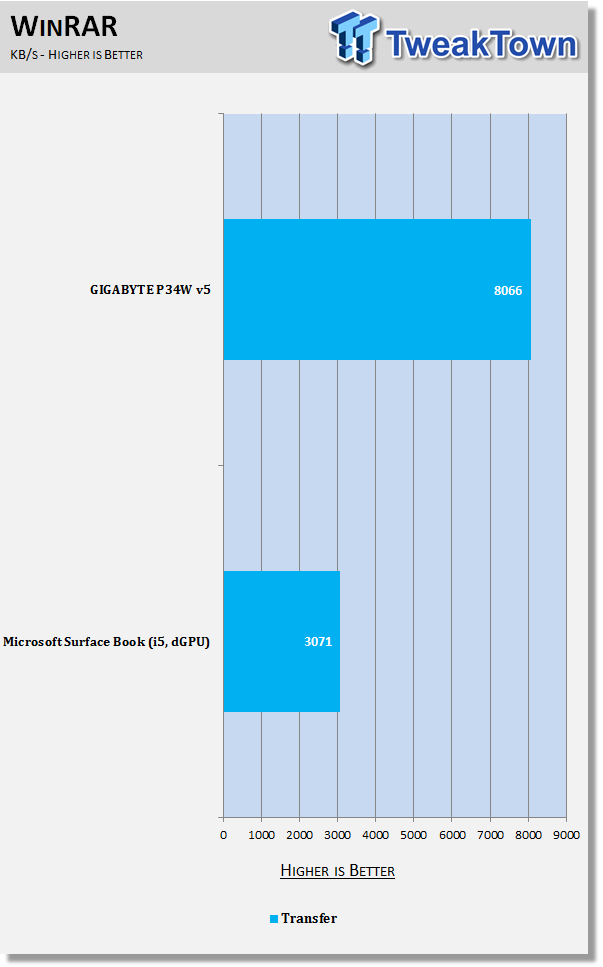
Compute is an important part of a lot of workloads, and thus we'll see how well, and fast, it can complete the tasks found in CompuBench, which does represent real workloads you might see in the wild, despite being a synthetic benchmark.
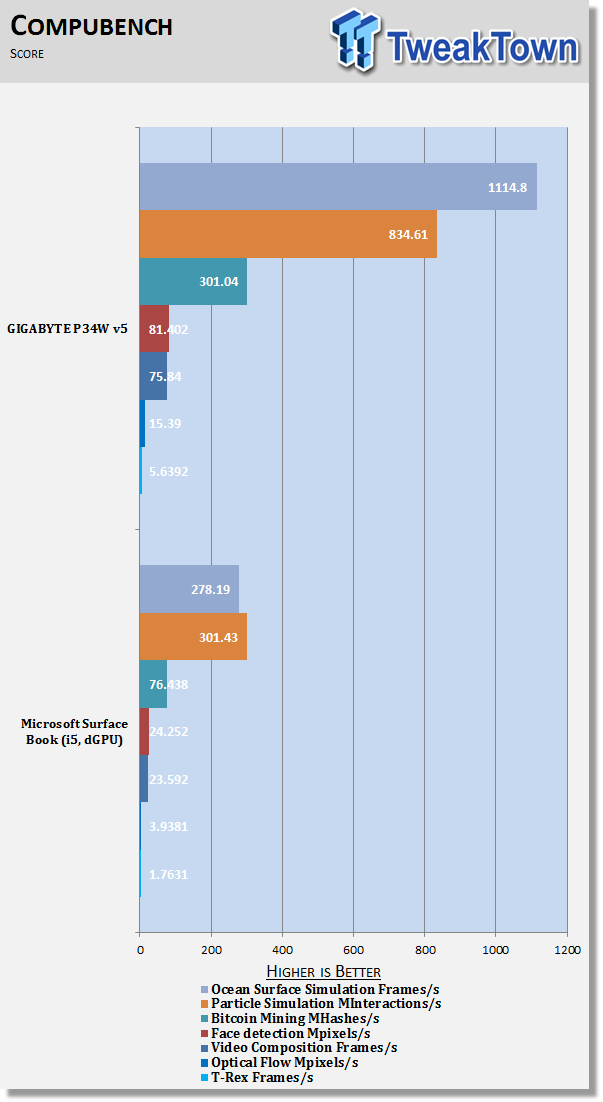
Benchmarks – Internal Storage & External Storage
Benchmarking the Internal Storage
Internally we have two drives for storage with the oft-used strategy of placing the OS and important programs on one drive and keeping everything else stored on another. This can help make the experience much speedier, even when looking to load games from the not-so-fast storage drive. The OS drive is a 128GB Samsung OEM unit that's NVMe compliant while the storage drive is a mechanical 1TB unit provided by Hitachi.
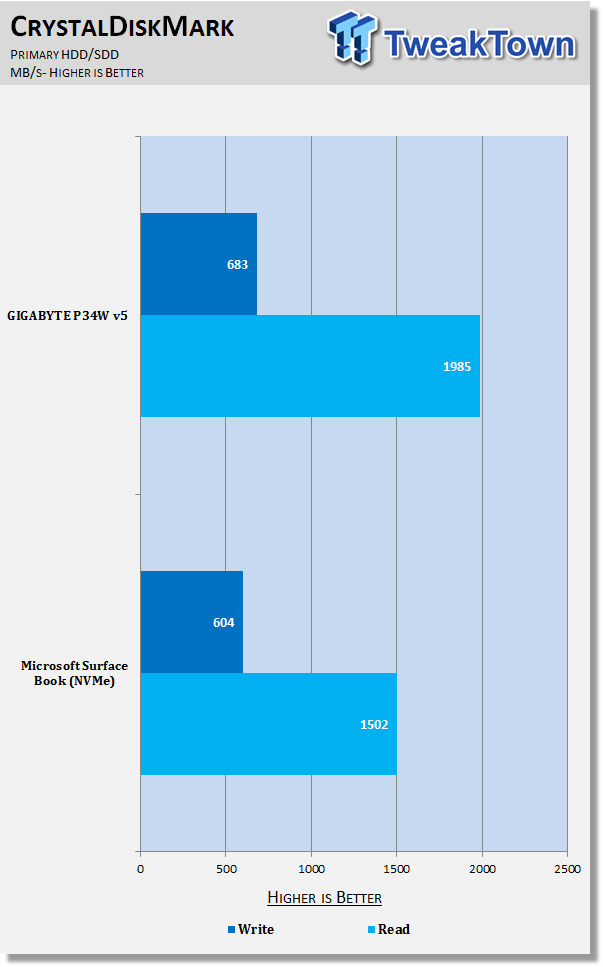
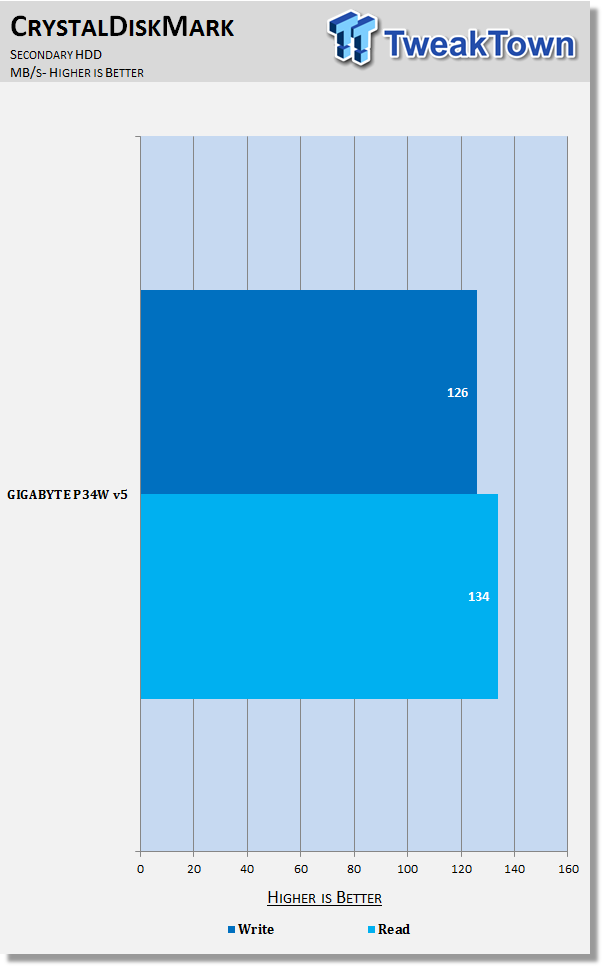
We might be spoiled by the speediness of the NVMe enabled M.2 drives, but that Hitachi mechanical HDD is still quite swift given its mechanical limitations. Like all of Samsung's forays into the solid state business, this too is quite fast.
Benchmarking the External Thunderbolt/USB Storage
It's exciting to see USB 3.1 Type-C make more of an appearance on more systems as of late. It has the potential to become a well-regarded standard just by the universal way in which you can plug things in, not the least bit because of the actual speed advantages the new port has. To test external file transfers, I took 8.81GB of 207 mixed files that are on a USB 3.0 enabled external SSD and transferred them, noting the average speed it was able to maintain throughout the full transfer.
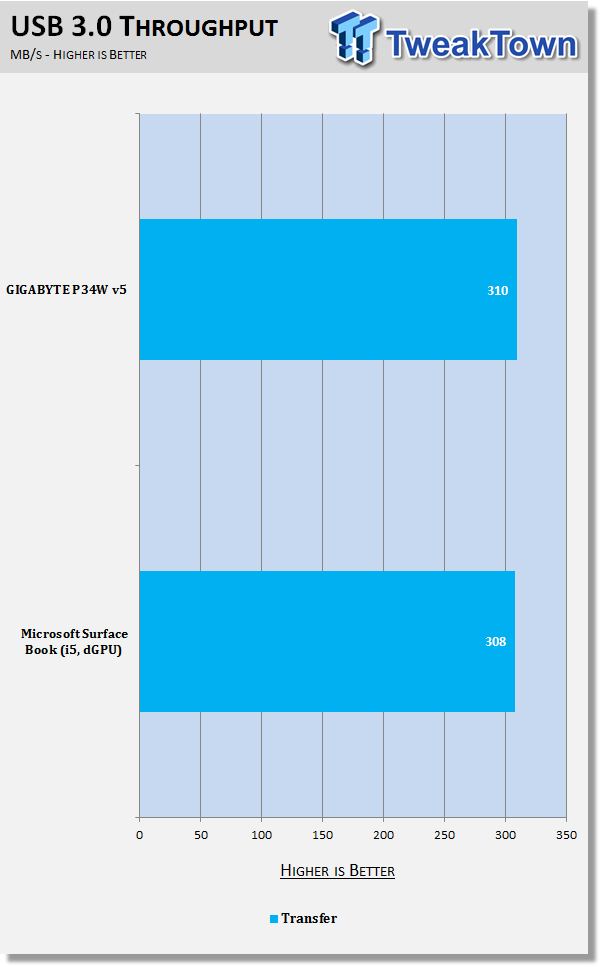
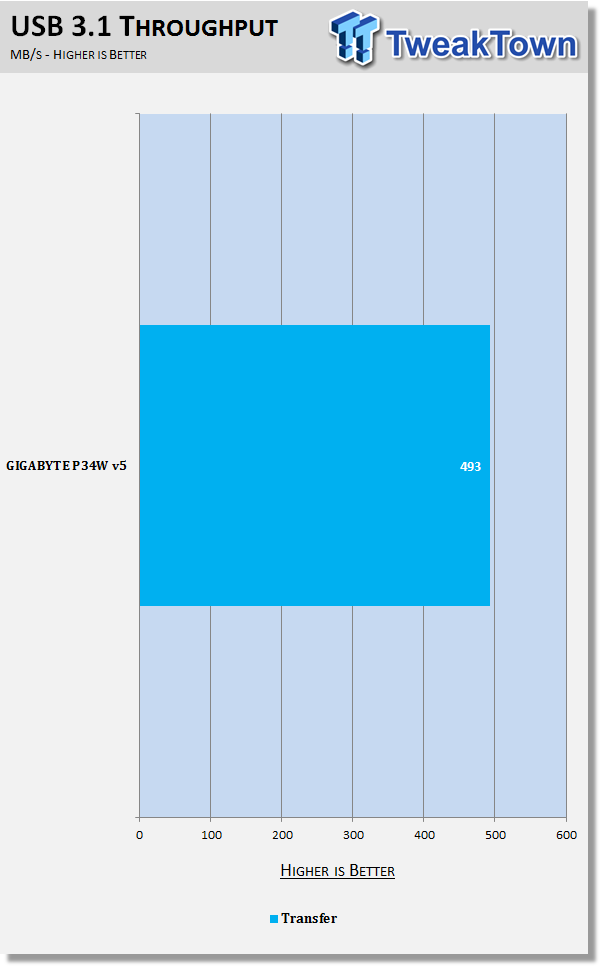
Power Consumption & Battery Life
Power Consumption
A 61.25Wh battery can potentially store a lot of energy in it, and in this case, it does. But there's also a lot of stuff inside that you have to power, too. Skylake is pretty power-efficient on its own with NVIDIA's Optimus.
Battery Life – How Long Can it Last?
For battery life testing, I wrote a custom script in Python (2.6) that automatically browses through the Internet until it dies, writing time codes to a log until it finally goes kaput. The sites repeat through a range of 10 different sites with a mixture of animation and flash heavy sites to actually task the battery. Facebook is thrown in as well for a little realism because, let's face it, that's what a lot of people do in their off time, right? Maybe not, but it seems to use a few CPU cycles to run, and is rather popular, so has been added in. Brightness was fixed at 100 nits.
The GIGABYTE P34W v5 lasted a decent amount during light usage, going strong for around 5.5 hours while editing offline documents while connected to the Internet though that's less scientific. During the actual test, we saw battery life around 4 hours and 15 minutes.
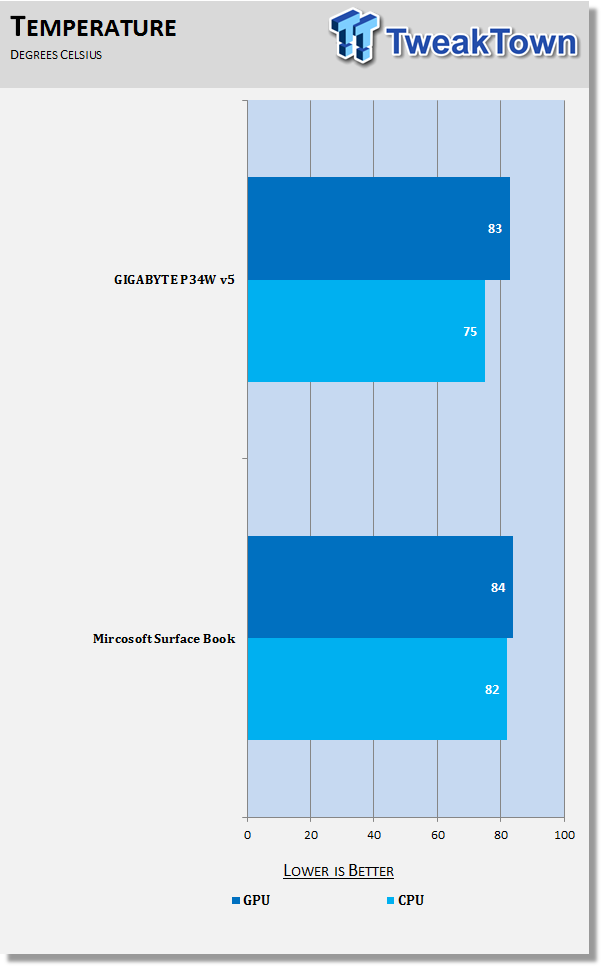
Thermal & Sound Testing
Thermal Testing – CPU/GPU
The thermal solution is a proprietary design that GIGABYTE has developed to be able to move the maximum amount of heat away in the most efficient manner. The GPU and CPU each have their own fans over their respective heat sinks. The problem is that it isn't exactly the best at keeping the system cool. During our testing, we noticed that under the most extreme of circumstances, when the CPU and the GPU are 100% stressed, that it would throttle. That kind of behavior didn't show up during normal operations, though, even though the hot air coming out was a bit uncomfortable, but that's also a sign that heat is being moved from the source.
NZXT's CAM software was used to log the temperature while playing Star Wars Battlefront for 30 minutes.
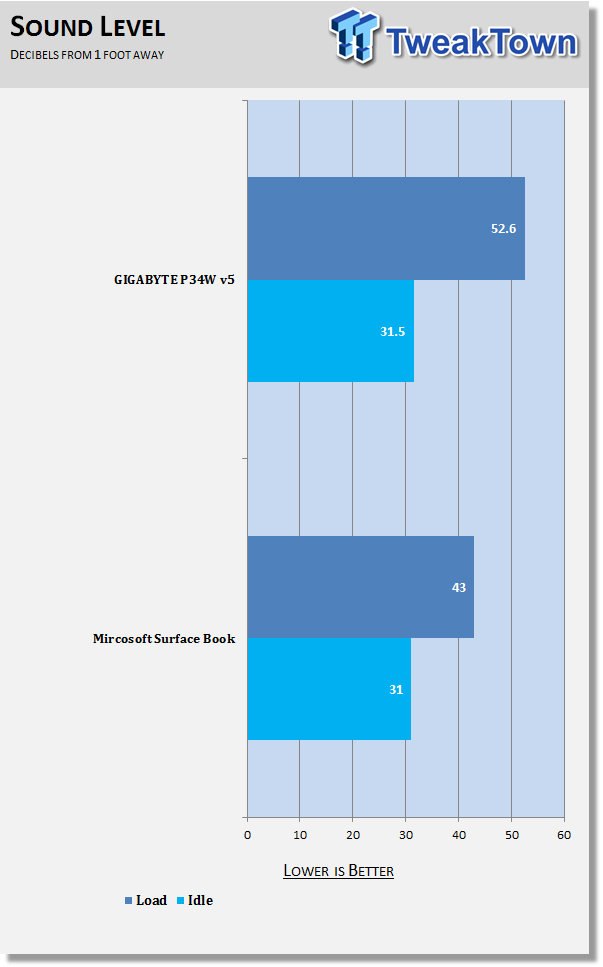
Thermals, thankfully, are well controlled, though again, this is under normal conditions you're likely to actually encounter.
Sound Testing
Noise is always a concern with a laptop. You want it to be as quiet as possible when browsing the web, and you also want the same when you're doing anything else that taxes the GPU and CPU. The problem is that physics doesn't make that possible at the moment, even with a relatively cool-running GTX 970M and the Skylake i7-6700HQ. Inevitably there'll be some noise. Here it's relatively well controlled, even under load settings. To measure this, we took a Reed R8050 and placed it 1 foot away from the laptop in a position that approximates where you'd sit, and took a reading while during the Battlefront temperature playthrough.
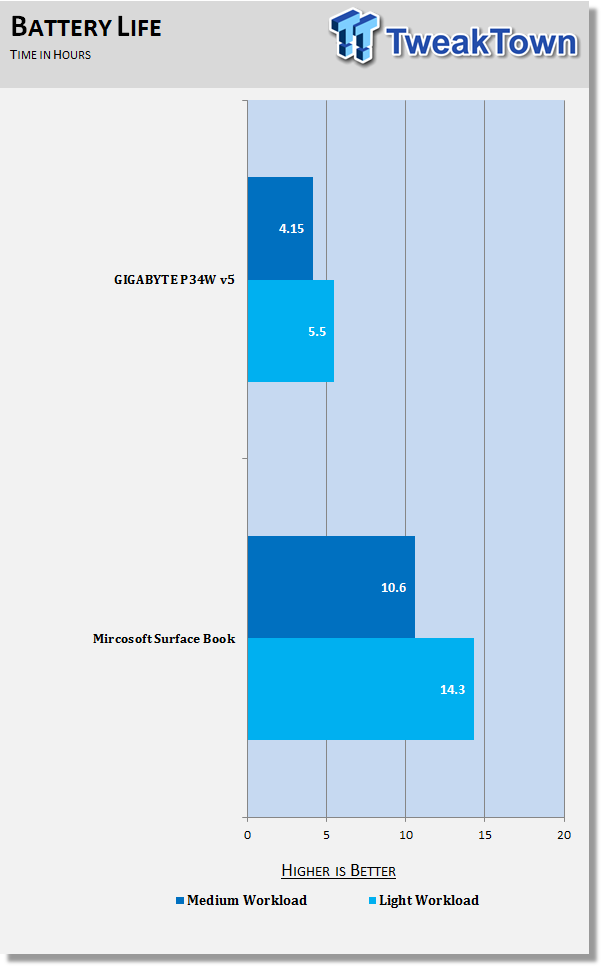
The results aren't so terrible, considering. At a reasonable and realistic load level, it's well under an annoying range. In fact, it's "quiet" and generally not noticeable with headphones in.
What's Hot, What's Not, and Final Thoughts
The GIGABYTE P34W v5 is actually a fantastic machine, a wolf in sheep's clothing, disguised as something benign while actually being a monster ready to take on the challenges of work or play. The exterior isn't the most premium though the price you pay is for the internals, a competent GPU paired with a powerful mobile GPU. It isn't perfect, but there are hardly any laptops that are precisely everything we want all-in-one package.
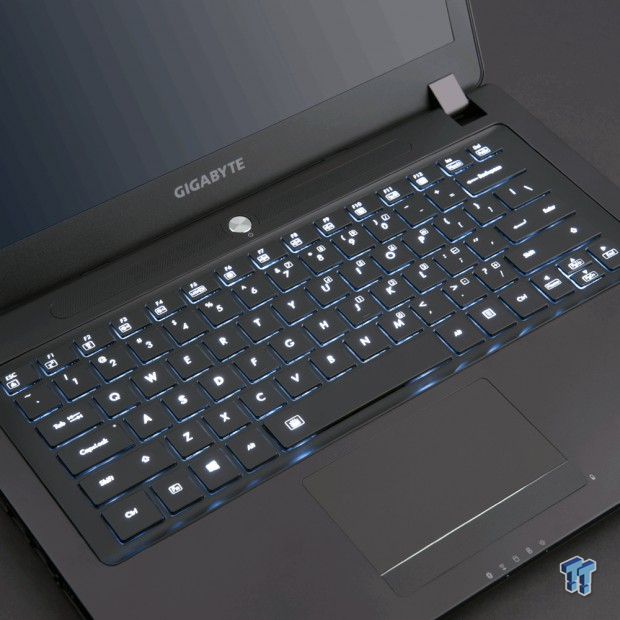
What's Hot
Price: Though it's "boring" on the outside, it's the price that's really attractive. Everything you need for a decent price.
Cool: Under normal loads the thermal system is very efficient, and no throttling was observed.
Business-like looks: Though "boring" and more traditional, the fact that it doesn't stand out is a good thing. It won't draw attention, and is a diamond in the rough.
GPU: Despite being mid-range, it's the perfect combination of performance/watt.
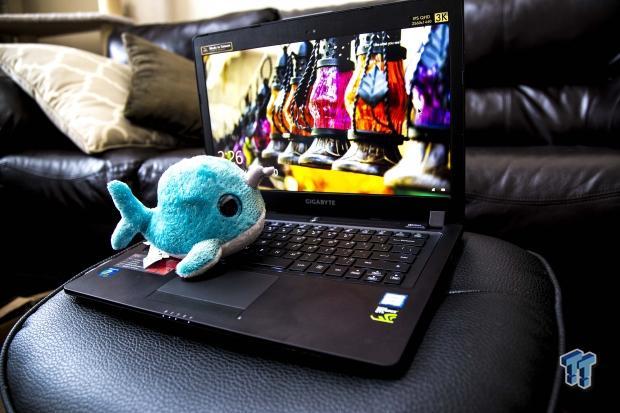
What's Not
Dim screen: Even with using the software controls to increase brightness, it still lags behind.
Touchpad: There's something not so nice about the touchpad, it just doesn't feel so great on the fingers, isn't quite as smooth.
Average speakers: They can get loud, but they still lack any punch or the full-body that is more appreciated.
Battery life: Though it isn't terrible, considering the large battery and power-sipping components, it's not quite what we would expect.
Final Thoughts
It's a fantastic machine in its own right. A monolithic block of aluminum and plastic melded together with a mix of GPU and CPU that actually makes for a potent combination. It's the perfect business machine for the connectivity alone, giving you options that many Dell or HP laptops no longer have and that some people might actually need.
Not only that, but it's capable of playing nearly any game or crunching through any process you need, though within limits. Sure, it's sometimes a bit loud, can get overly warm if you're not careful and might have battery life that's bested by less expensive machines. But it's a slim package with everything you could need for a fairly good price.
The combination of components makes it an interesting proposition that should be on your radar if you're looking for a dedicated gaming laptop. It isn't perfect, by any means, but it's a strange concoction that's surprising when in actual use.
